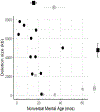Incontinence in Phelan-McDermid Syndrome
- PMID: 30921255
- PMCID: PMC6658348
- DOI: 10.1097/MPG.0000000000002342
Incontinence in Phelan-McDermid Syndrome
Abstract
Objective: The aim of the study was to evaluate gastrointestinal symptoms and continence in the context of Phelan-McDermid Syndrome (PMS).
Methods: A prospective evaluation of children with PMS (n = 17) at the National Institutes of Health.
Results: Parent-reported history of symptoms were common: constipation (65%), reflux (59%), choking/gagging (41%), and more than half received gastrointestinal specialty care. No aspiration was noted in 11/11 participants who completed modified barium swallows. Four participants met criteria for functional constipation, 2 of whom had abnormal colonic transit studies. Stool incontinence was highly prevalent (13/17) with nonretentive features present in 12/17. Participants who were continent had significantly smaller genetic deletions (P = 0.01) and higher nonverbal mental age (P = 0.03) compared with incontinent participants.
Conclusions: Incontinence is common in PMS and associated with intellectual functioning and gene deletion size. Management strategies may differ based on the presence of nonretentive fecal incontinence, functional constipation, and degree of intellectual disability for children with PMS.
Trial registration: ClinicalTrials.gov NCT01778504.
Conflict of interest statement
Conflict of interest:
The authors have no conflicts of interest relevant to this article to disclose. For the primary author, salary funding was provided by the United States Department of Defense. The views expressed in this work are those of the authors and do not necessarily reflect the official policy or position of the United States Air Force, the United States Army, the Department of Defense, or the U.S. Government. Title 17 U.S.C. 101 defines a United States Government work as ‘a work prepared by a military service member or employee of the United States Government as part of that person’s official duties.’ This work was prepared as part of the official duties of the authors.
Figures

References
-
- Phelan K, Rogers RC, Boccuto L. Phelan-McDermid Syndrome. GeneReviews 2005; Updated 2018. https://www.ncbi.nlm.nih.gov/books/NBK1198/
-
- Sarasua SM, Boccuto L, Sharp JL, et al. Clinical and genomic evaluation of 201 patients with Phelan-McDermid syndrome. Hum Genet 2014;133:847–59. - PubMed
Publication types
MeSH terms
Supplementary concepts
Associated data
Grants and funding
LinkOut - more resources
Full Text Sources
Medical
Miscellaneous

